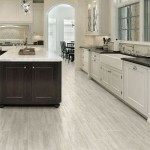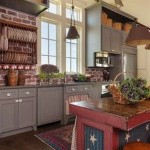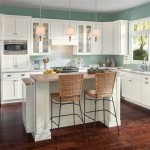Farmhouse Style Kitchen Islands Adding Character To Your Room
The kitchen, often considered the heart of the home, is a space where functionality and aesthetics intertwine. A well-designed kitchen island can serve as a focal point, enhancing both the practicality and the visual appeal of the room. In recent years, the farmhouse style kitchen island has gained immense popularity, becoming a sought-after feature for homeowners seeking a blend of rustic charm and modern convenience. These islands are more than just a countertop with storage; they are statements of character, breathing warmth and personality into any kitchen space.
The allure of the farmhouse style lies in its simplicity, authenticity, and connection to nature. It evokes a sense of nostalgia for a simpler time, away from the sleek, minimalist designs that often dominate contemporary interiors. The farmhouse aesthetic embraces natural materials, repurposed elements, and handcrafted details, creating a welcoming and comfortable environment. When incorporated into a kitchen island, these elements can transform an ordinary space into a captivating and inviting hub.
Farmhouse style kitchen islands stand out due to their unique design elements. Think of distressed wood finishes, shiplap siding, open shelving, butcher block countertops, and vintage-inspired hardware. These details work together to create a cohesive and visually appealing piece that seamlessly blends with the existing kitchen décor while simultaneously adding a touch of rustic elegance. The possibilities are vast, ranging from repurposing antique furniture to incorporating salvaged architectural components.
Functionality and Form: The Core Principles
A farmhouse style kitchen island is not simply about aesthetics; it is also about enhancing the functionality of the kitchen. At its most basic, it provides additional countertop space, which is invaluable for food preparation, baking, and even casual dining. This extra surface area can alleviate congestion in smaller kitchens, allowing for multiple people to work comfortably together. The island also serves as a central gathering point, encouraging interaction and conversation within the family.
Beyond the countertop, farmhouse islands often incorporate ample storage solutions. Drawers, cabinets, and open shelving provide convenient places to store cookware, utensils, and pantry items. The open shelving in particular is a hallmark of the farmhouse style, allowing homeowners to display their favorite dishes, cookbooks, or decorative items. This creates a lived-in, personalized atmosphere and adds visual interest to the island.
Many farmhouse islands also include built-in appliances, such as a microwave, wine cooler, or even an extra sink. Integrating appliances into the island helps to streamline the kitchen layout and maximize efficiency. A prep sink, for example, can be incredibly useful for washing vegetables or rinsing dishes, reducing the need to constantly move back and forth between the main sink and the stovetop.
Consider the specific needs of your household when designing a farmhouse style kitchen island. Do you need more seating for casual meals? Perhaps a larger countertop area for baking projects? Or maybe you prioritize storage space for bulky pots and pans? By carefully considering your needs, you can create an island that is both beautiful and highly functional.
Key Design Elements of Farmhouse Style Islands
Several design elements contribute to the distinctive look and feel of a farmhouse style kitchen island. These elements range from the materials used to the finishes applied, all working harmoniously to create a cohesive and charming aesthetic.
Wood Finishes: Distressed wood is a quintessential feature of farmhouse style. This look can be achieved through various methods, such as sanding, staining, and antiquing. The goal is to create a finish that appears weathered and aged, as if the wood has been around for generations. Reclaimed wood is another excellent option, adding a unique character and history to the island. When using reclaimed wood, it is important to ensure that it is properly cleaned and treated to prevent any issues.
Countertops: Butcher block countertops are a popular choice for farmhouse islands. The warm, natural tones of the wood complement the rustic aesthetic and provide a durable, food-safe surface. Other countertop options include granite, marble, and quartz. These materials offer a more polished look while still maintaining a connection to nature. Consider the overall color scheme of your kitchen when choosing a countertop material. A light-colored countertop can brighten up a dark space, while a darker countertop can add depth and drama.
Hardware: Hardware is often overlooked, but it can have a significant impact on the overall look of a farmhouse island. Vintage-inspired knobs and pulls, such as those made of cast iron or antique brass, are excellent choices. These details add a touch of character and authenticity to the island. Consider the size and style of the hardware in relation to the size and style of the cabinets and drawers. Overly large hardware can overwhelm smaller cabinets, while overly small hardware can get lost on larger cabinets.
Shiplap and Beadboard: Shiplap and beadboard are both types of paneling that are commonly used in farmhouse style interiors. Shiplap consists of horizontal planks that overlap, creating a textured surface. Beadboard features vertical grooves and raised beads, adding visual interest to the island. Either of these paneling options can be used to clad the sides of the island, creating a charming and rustic look.
Open Shelving: Open shelving is a defining characteristic of the farmhouse style. It allows homeowners to display their favorite dishes, cookbooks, and decorative items. Open shelving can also be used to store frequently used items, making them easily accessible. When styling open shelves, it is important to maintain a balance between functionality and aesthetics. Avoid overcrowding the shelves and choose items that complement each other in terms of color, texture, and style.
Integrating the Island into Your Existing Kitchen
Successfully integrating a farmhouse style kitchen island into an existing kitchen requires careful planning and consideration. The island should complement the existing décor while also adding its own unique character to the space. Consider the following factors when planning your island:
Size and Scale: The size of the island should be proportionate to the size of the kitchen. An oversized island can overwhelm a small kitchen, while an undersized island can get lost in a large kitchen. Consider the traffic flow around the island and ensure that there is enough space for people to move comfortably. A good rule of thumb is to allow at least 36 inches of clearance between the island and the surrounding counters and appliances.
Layout: The layout of the island should be functional and efficient. Consider the placement of appliances, sinks, and seating in relation to the island. A well-designed layout can streamline workflow and make the kitchen more enjoyable to use. For example, placing a prep sink near the stovetop can make it easier to wash vegetables while cooking.
Materials and Finishes: The materials and finishes used for the island should complement the existing materials and finishes in the kitchen. Consider the color scheme, texture, and style of the cabinets, countertops, and flooring. A cohesive design will create a unified and harmonious look. If you are unsure about which materials and finishes to choose, consult with a kitchen designer or interior decorator.
Lighting: Proper lighting is essential for any kitchen, and the island is no exception. Consider incorporating pendant lights or chandeliers above the island to provide task lighting and create a focal point. Recessed lighting can also be used to illuminate the surrounding areas. Choose lighting fixtures that complement the farmhouse style and provide adequate illumination for food preparation and other tasks.
Personalization: Finally, be sure to personalize the island to reflect your own unique style and personality. Add decorative touches that make the island feel like home. This could include displaying family heirlooms, artwork, or collections. The goal is to create an island that is both beautiful and functional, and that reflects your own individual taste.
The farmhouse style kitchen island offers a unique opportunity to bring warmth, character, and functionality into your kitchen. By carefully considering the design elements and integration strategies discussed above, homeowners can create a space that is both beautiful and practical, a true heart of the home. The enduring appeal of the farmhouse aesthetic ensures that these islands will remain a popular and cherished feature in kitchens for years to come.

17 Best Modern Farmhouse Kitchen Ideas That Will Inspire You

40 Best Kitchen Island Ideas For Your Home

100 Kitchen Island Transformation Thrifty Decor Diy And Organizing

17 Best Modern Farmhouse Kitchen Ideas That Will Inspire You

Adding Character To A Kitchen Seeking Lavender Lane

Rustic Kitchen Island Options Wellcraft Kitchens

71 Best Kitchen Island Ideas For Kitchens Of Every Size And Style

17 Best Modern Farmhouse Kitchen Ideas That Will Inspire You

Adding Character To A Basic Kitchen Island The Lettered Cottage

Rustic Kitchen Island With Seating And Storage Rocky Hedge Farm
Related Posts








